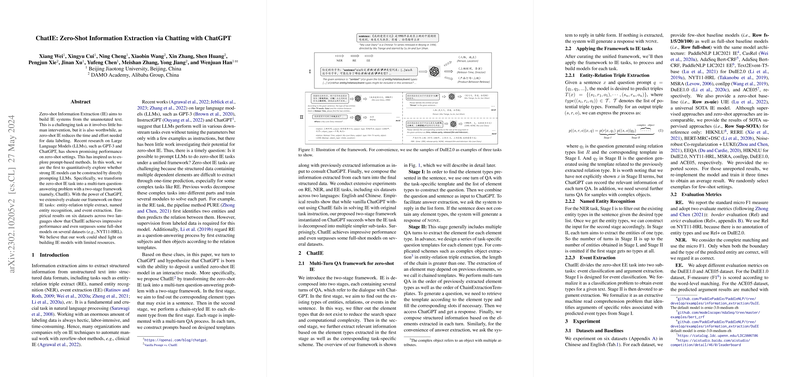Zero-Shot Information Extraction via Chatting with ChatGPT: An Expert Overview
The paper "Zero-Shot Information Extraction via Chatting with ChatGPT" explores a novel methodology for Information Extraction (IE) using LLMs, specifically ChatGPT, in zero-shot settings. By transforming the IE task into a multi-turn question-answering framework, the authors introduce ChatIE. This approach leverages the conversational capabilities of ChatGPT to perform tasks such as entity-relation triple extraction, named entity recognition, and event extraction without prior training or parameter fine-tuning.
Methodology
The proposed framework, ChatIE, is a two-stage process:
- Stage I: This stage identifies potential element types within a sentence using a single-turn QA approach. The target is to filter out non-relevant types to minimize computational complexity.
- Stage II: Once the relevant types are identified, this stage proceeds to extract specific information using a multi-turn QA process. The chaining of questions allows the model to recursively refine and contextualize its outputs.
This dual-stage process is designed to break down complex IE tasks into manageable sub-tasks, allowing ChatGPT's capabilities to be harnessed without extensive labeled data or computational resources.
Experimental Evaluation
The authors conducted experiments across various datasets, including NYT11-HRL for entity-relation extraction and MSRA for named entity recognition. ChatIE was evaluated for its ability to compete with, and in some cases, surpass, existing models trained with full or few-shot learning methods.
- Key Results: On datasets such as DuIE2.0 and DuEE1.0, ChatIE outperformed full-shot models, a significant result given the absence of prior task-specific training. This underscores the robustness of ChatGPT's pre-trained language understanding when strategically prompted.
- Comparative Analysis: ChatIE's performance was notably better than several few-shot baselines and even some traditional supervised models like FCM and MultiR on NYT11-HRL, achieving an F1 score increment averaging 18.98% across all tests.
Implications and Future Directions
The findings in this paper highlight the potential of leveraging conversational models in structured IE tasks, suggesting a paradigm shift towards interactive, prompt-based extraction methods. The framework could serve as a blueprint for developing IE systems that function effectively in low-resource environments, significantly reducing the time and expertise needed for model training.
From a theoretical standpoint, this work indicates that LLMs can generalize across tasks with high complexity purely through appropriately designed interactive prompts. This insight opens avenues for future research in implicit knowledge utilization within LLMs, enhancing their applicability to further NLP tasks without additional parameter adjustments.
Conclusion
The paper makes a compelling case for the integration of multi-turn conversational formats in zero-shot information extraction. ChatIE's success in both cross-language and multi-task contexts demonstrates the strategic advantage of employing a dialogue-based methodology. Future research could expand on optimizing prompt design and exploring additional domains where this approach can be effectively applied. This work represents substantial progress in the efficient use of LLMs for sophisticated information extraction tasks.
